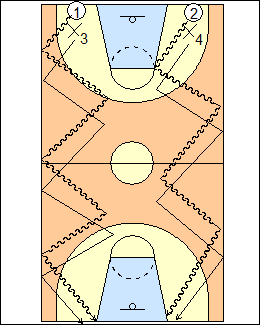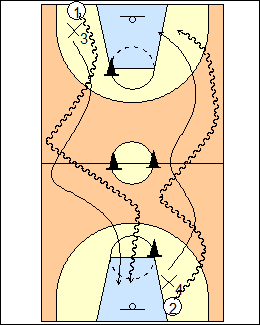DeMatha zig-zag
 | 1 Mike Jones 1) 1-on-1 zig-zag on each side, stay between the sideline and elbows extended, everyone goes down, repeat coming back. a) Go about 50% on offence, the defender turns the attacker fullcourt (make him change direction). b) The attacker goes 90-100%, how many times can the defender turn him. See Pressing - Billy Tubbs. |
 | 2 2) Start from both ends, zig-zag to halfcourt (how many times can you turn the attacker) then live 1-on-1 in the frontcourt using 2/3 of the court (from the sideline to the far elbow extended). The defender tries to keep the attacker on one side. Ian MacKinnon - match up, keep scores, defenders get one point each time they turn an attacker in the backcourt (play between the sideline and near lane line extended), no restrictions in the frontcourt, attackers get one point if they get into the paint with their strong hand, another point for a basket. (Option - play to a stop or score, with one point for an offensive rebound.) Chris Oliver - he doesn’t like the zig-zag drill, defenders covering a dribbler in the fullcourt rarely slide in such a controlled way, they are constantly running and recovering (crossover step, sprint, jump turn to get back to a chest-to-chest position). His suggestion is skip the zig-zag drill and run a fullcourt one-on-one drill, the defender tries to keep the ball in front, stay chest-to-chest, and turn the dribbler as often as possible; the dribbler should attack fast in a straight line and use change of pace (stop and go) to create space (if a second defender comes up in a game, invite a double-team by using a pull-back dribble to pull both defenders towards you, creating space and a potential pass or dribble out). Drew Hanlen - offensive goal is maximum backcourt "breaks" (separation from defender's hand), pass to coach at halfcourt for return pass, play 1-on-1, dribbles equal to number of breaks, defence can steal or deflect the passes. Progression - live fullcourt, see 1 on 1 - Spurs fullcourt, also Defending - Zig-zag, Slide and run, Pressing - Pasquali.  |
This page was made with Basketball playbook from Jes-Soft